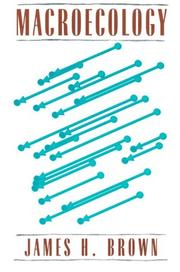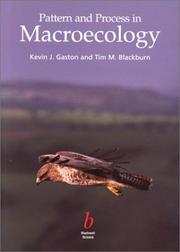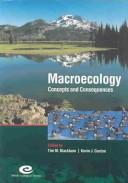| Listing 1 - 10 of 18 | << page >> |
Sort by
|

ISBN: 0226076148 0226076156 Year: 1995 Publisher: Chicago (Ill.) : University of Chicago press,
Abstract | Keywords | Export | Availability | Bookmark
 Loading...
Loading...Choose an application
- Reference Manager
- EndNote
- RefWorks (Direct export to RefWorks)
In 'Macroecology', James H. Brown proposes a radical new research agenda designed to broaden the scope of ecology to encompass vast geographical areas and very long time spans. While much ecological research is narrowly focused and experimental, providing detailed information that cannot be used to generalize from one ecological community or time period to another, macroecology draws on data from many disciplines to create a less detailed but much broader picture with greater potential for generalization. Integrating data from ecology, systematics, evolutionary biology, paleobiology, and biogeography to investigate problems that could only be addressed on a much smaller scale by traditional approaches, macroecology provides a richer, more complete understanding of how patterns of life have moved across the earth over time. Brown also demonstrates the advantages of macroecology for conservation, showing how it allows scientists to look beyond endangered species and ecological communities to consider the long history and large geographic scale of human impacts. An important reassessment of the direction of ecology by one of the most influential thinkers in the field, this work will shape future research in ecology and other disciplines. "This approach may well mark a major new turn in the road in the history of ecology, and I find it extremely exciting. The scope of Macroecology is tremendous and the book makes use of its author's exceptionally broad experience and knowledge. An excellent and important book."--Lawrence R. Heaney, Center for Environmental and Evolutionary Biology, the Field Museum
Book
ISBN: 0226904113 9780226904115 9780226904122 0226904121 1282426966 9786612426964 0226904148 9780226904146 9781282426962 Year: 2009 Publisher: Chicago University Press
Abstract | Keywords | Export | Availability | Bookmark
 Loading...
Loading...Choose an application
- Reference Manager
- EndNote
- RefWorks (Direct export to RefWorks)
Pioneered in the late 1980s, the concept of macroecology-a framework for studying ecological communities with a focus on patterns and processes-revolutionized the field. Although this approach has been applied mainly to terrestrial ecosystems, there is increasing interest in quantifying macroecological patterns in the sea and understanding the processes that generate them. Taking stock of the current work in the field and advocating a research agenda for the decades ahead, Marine Macroecology draws together insights and approaches from a diverse group of scientists to show
Ecology. --- Macroecology. --- Marine ecology. --- Marine ecology --- Macroecology --- Ecology --- Earth & Environmental Sciences --- Biological oceanography --- Marine ecosystems --- Ocean --- Aquatic ecology
Book
ISBN: 9781108569422 9781108752039 9781108477079 1108477070 9781108701877 1108701876 Year: 2020 Publisher: Cambridge Cambridge University Press
Abstract | Keywords | Export | Availability | Bookmark
 Loading...
Loading...Choose an application
- Reference Manager
- EndNote
- RefWorks (Direct export to RefWorks)
The speciesarea relationship (SAR) describes a range of related phenomena that are fundamental to the study of biogeography, macroecology and community ecology. While the subject of ongoing debate for a century, surprisingly, no previous book has focused specifically on the SAR. This volume addresses this shortfall by providing a synthesis of the development of SAR typologies and theory, as well as empirical research and application to biodiversity conservation problems. It also includes a compilation of recent advances in SAR research, comprising novel SAR-related theories and findings from the leading authors in the field. The chapters feature specific knowledge relating to terrestrial, marine and freshwater realms, ensuring a comprehensive volume relevant to a wide range of fields, with a mix of review and novel material and with clear recommendations for further research and application.
Biogeography. --- Macroecology. --- Numbers of species. --- Spatial ecology. --- Species diversity --- Statistical methods.
Book
ISBN: 3031446119 Year: 2023 Publisher: Cham, Switzerland : Springer,
Abstract | Keywords | Export | Availability | Bookmark
 Loading...
Loading...Choose an application
- Reference Manager
- EndNote
- RefWorks (Direct export to RefWorks)
This comprehensive volume discusses the patterns and processes analyzed in macroecology with a distinct look at the theoretical and methodological issues underlying the discipline as well as deeper epistemological matters. The book serves as a synthesis of macroecological literature that has been published since Brown and Maurer proposed and defined the term “macroecology” in 1989. Author José Alexandre Felizola Diniz-Filho draws from the different disciplines and branches (ecology, evolutionary biology, physiology, behavioral sciences, climatology, and paleontology) that make up macroecology to present a full, holistic picture of where the discipline stands. Through ten chapters, Diniz-Filho moves from a discussion of what macroecology actually is to macroecological modeling to the more applied side of the discipline, covering topics such as richness and diversity patterns and patterns in body size. The book concludes with a synthesis of how macroecological research is done in a theoretical and operational sense as well as unifying explanations for each of the macroecological patterns discussed, moving on to evaluate which theories and models are still useful and which ones can be abandoned. The book is intended for academics, young researchers and students interested in macroecology and conservation biogeography. In addition, because of the integrative nature of macroecology and the theoretical and methodological background in the book, it can be of interest to researchers working in related fields including but not limited to ecology and evolutionary biology.
Ecology. --- Biodiversity. --- Biotic communities. --- Population biology. --- Biogeography. --- Community and Population Ecology. --- Biogeosciences. --- Macroecology.
Book
ISBN: 1108752039 110875807X 1108569420 Year: 2020 Publisher: Cambridge : Cambridge University Press,
Abstract | Keywords | Export | Availability | Bookmark
 Loading...
Loading...Choose an application
- Reference Manager
- EndNote
- RefWorks (Direct export to RefWorks)
The species-area relationship (SAR) describes a range of related phenomena that are fundamental to the study of biogeography, macroecology and community ecology. While the subject of ongoing debate for a century, surprisingly, no previous book has focused specifically on the SAR. This volume addresses this shortfall by providing a synthesis of the development of SAR typologies and theory, as well as empirical research and application to biodiversity conservation problems. It also includes a compilation of recent advances in SAR research, comprising novel SAR-related theories and findings from the leading authors in the field. The chapters feature specific knowledge relating to terrestrial, marine and freshwater realms, ensuring a comprehensive volume relevant to a wide range of fields, with a mix of review and novel material and with clear recommendations for further research and application.
Species diversity --- Spatial ecology. --- Numbers of species. --- Macroecology. --- Biogeography. --- Statistical methods.

ISBN: 0632056533 9780632056538 Year: 2000 Publisher: Oxford Blackwell
Abstract | Keywords | Export | Availability | Bookmark
 Loading...
Loading...Choose an application
- Reference Manager
- EndNote
- RefWorks (Direct export to RefWorks)
Macroecology. --- ECO Ecology --- Great Britain --- biodiversity --- ecology --- macroecology --- ornithology --- Biosynthèse --- Biosynthesis --- Biotope --- biotopes --- Structure de la population --- population structure --- Distribution des populations --- Population distribution --- General ecology and biosociology --- Animal population --- plant population
Periodical
ISSN: 19486596
Abstract | Keywords | Export | Availability | Bookmark
 Loading...
Loading...Choose an application
- Reference Manager
- EndNote
- RefWorks (Direct export to RefWorks)
Biogeography --- Biodiversity conservation --- Biodiversity conservation. --- Biogeography. --- macroecology --- phylogeography --- climate change --- evolutionary biology --- biogeography --- paleobiology --- General microbiology --- General ecology and biosociology
Book
ISBN: 9780199608713 0199608717 Year: 2019 Publisher: Oxford : Oxford University Press,
Abstract | Keywords | Export | Availability | Bookmark
 Loading...
Loading...Choose an application
- Reference Manager
- EndNote
- RefWorks (Direct export to RefWorks)
"Origins of Biodiversity" is a unique introduction to the fields of macroevolution and macroecology, which explores the evolution and distribution of biodiversity across time, space and lineages. Using an enquiry-led framework to encourage active learning and critical thinking, each chapter is based around a case-study to explore concepts and research methods from contemporary macroevolution and macroecology.The book focuses on the process of science as much as the biology itself, to help students acquire the research skills and intellectual tools they need to understand and investigate the biological world around them. In particular, the emphasis on hypothesis testing encourages students to develop and test their own ideas.This text builds upon the foundations offered in most general introductory evolutionary biology courses to introduce an exciting range of ideas and research tools for investigating patterns of biodiversity.
Biodiversity. --- Evolution (Biology) --- Macroecology. --- Évolution (biologie) --- Macroévolution. --- Macroécologie. --- Biodiversity --- Macroevolution --- Macroecology --- Ecology --- Biological diversification --- Biological diversity --- Biotic diversity --- Diversification, Biological --- Diversity, Biological --- Biology --- Biocomplexity --- Ecological heterogeneity --- Numbers of species --- 574.472 --- 574.472 Biodiversity --- Évolution (biologie) --- Macroévolution. --- Macroécologie.
Periodical
ISSN: 07194986 Publisher: [S.l.] Centro de Estudios en Biodiversidad
Abstract | Keywords | Export | Availability | Bookmark
 Loading...
Loading...Choose an application
- Reference Manager
- EndNote
- RefWorks (Direct export to RefWorks)
Biodiversity --- Biodiversity. --- Biological diversification --- Biological diversity --- Biotic diversity --- Diversification, Biological --- Diversity, Biological --- biodiversity --- ecology --- taxonomy --- biogeography --- macroecology --- systematics --- Biology --- Biocomplexity --- Ecological heterogeneity --- Numbers of species --- General ecology and biosociology

ISBN: 1405106425 1405106433 9781405106429 Year: 2003 Publisher: Oxford Blackwell
Abstract | Keywords | Export | Availability | Bookmark
 Loading...
Loading...Choose an application
- Reference Manager
- EndNote
- RefWorks (Direct export to RefWorks)
This volume brings together a collection of leading practitioners in the discipline. It presents an overview of current thinking about the development of macroecological patterns, with the aim of reconciling areas of contention.
General ecology and biosociology --- 574.472 --- 574.9 --- 57.018.4 --- Biodiversity --- Biogeography in general. Geographical distribution of organisms --- Size. Volume. Dimensions --- Macroecology --- 57.018.4 Size. Volume. Dimensions --- 574.9 Biogeography in general. Geographical distribution of organisms --- 574.472 Biodiversity --- Ecology
| Listing 1 - 10 of 18 | << page >> |
Sort by
|

 Search
Search Feedback
Feedback About UniCat
About UniCat  Help
Help News
News